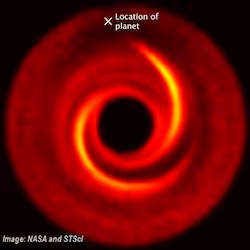Young planets
New age telescopes can see inside young solar systems to show how gravity creates new planets.

⚡ Young solar systems have spiral arms similar to galaxies.
⚡ Baby solar systems have one or two giant planets whose gravity attracts particles around it.
⚡ Spiral arms are made by gas and dust collecting around giant planets.
⚡ Early planets create smaller planets in a solar system.
⚡ Our solar system started out with Jupiter. Jupiter's gravity led to formation of small planets.
⚡ Baby solar systems look hazy through telescopes because they have gas and dust.
⚡ Latest infrared telescopes like LBTI (Large Binocular Telescope Interferometer) and JWST (James Webb Space Telescope) can see inside baby glaxies.
Solar Storms
Solar Storms are energy bursts from the Sun. They create electric and magnetic disturbances on Earth. Watch live streaming of movements on the Sun using NASA's SDO website.
⚡ Solar storms are called Solar Flares, Geomagnetic Storms, Coronal mass ejections (CME).
⚡ High speed electrons within the Sun clash with its plasma causing solar storms.
⚡ Solar flares are energy waves. Sometimes, they are followed by jets of particles called CMEs.
⚡ Solar flares damage electricity grids, satellite and radio signals on Earth.
⚡ Solar storms pose a risk to astronauts and ongoing space missions.
⚡ Solar flares are detected by NASA's SDO (Solar Dynamics Observatory)
